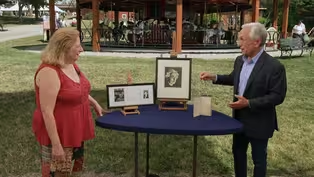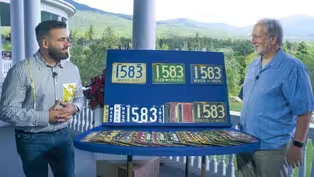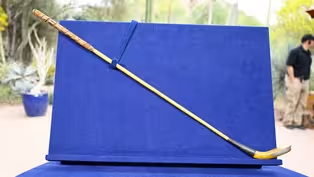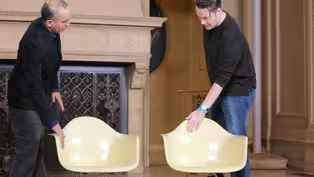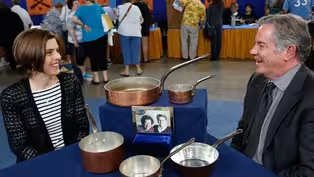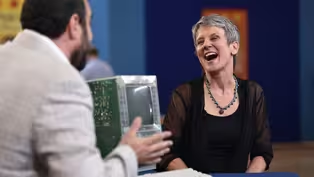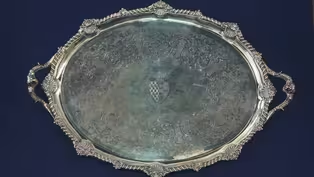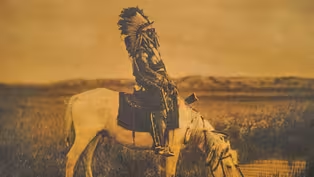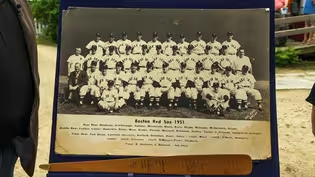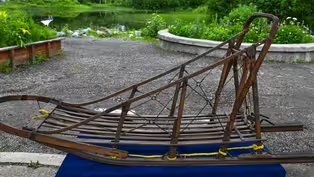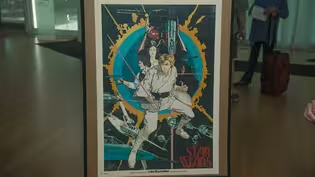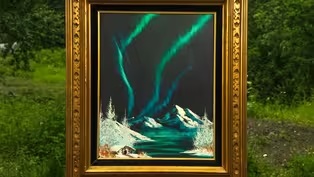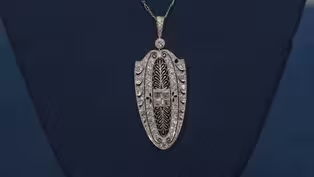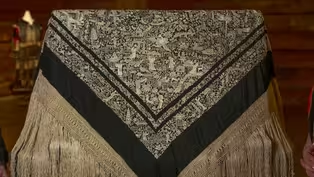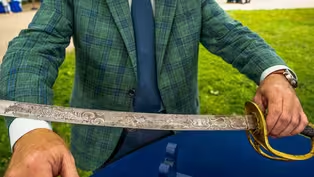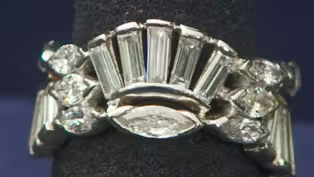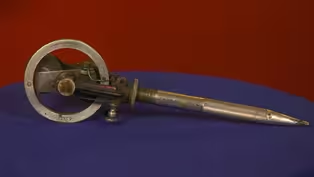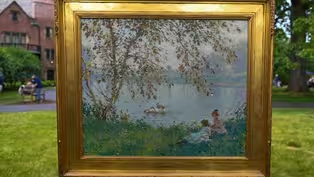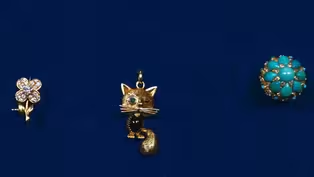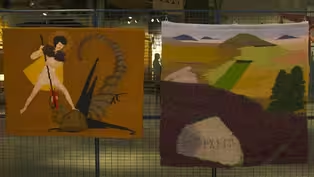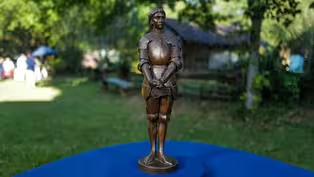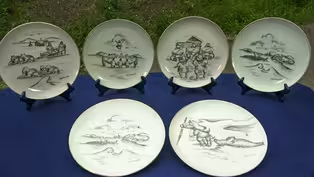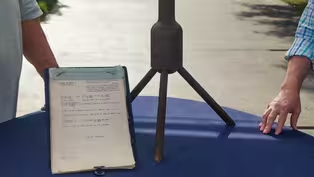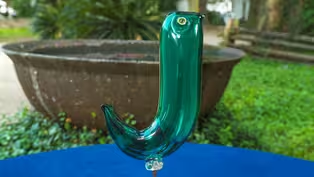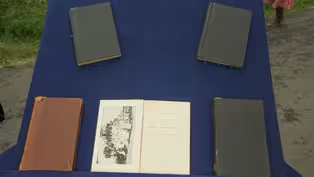
Junk in the Trunk 13
Season 28 Episode 25 | 52m 25sVideo has Closed Captions
Travel to all five cities of ROADSHOW's Season 28 Tour for never-before-seen appraisals!
Travel to all five cities of ROADSHOW's Season 28 Tour for never-before-seen appraisals, including a 1976 Mark Hamill-signed Star Wars poster, a 1979 Bob Ross landscape oil, and a 1973 Iditarod Race sled!
Problems playing video? | Closed Captioning Feedback
Problems playing video? | Closed Captioning Feedback
Funding for ANTIQUES ROADSHOW is provided by Ancestry and American Cruise Lines. Additional funding is provided by public television viewers.

Junk in the Trunk 13
Season 28 Episode 25 | 52m 25sVideo has Closed Captions
Travel to all five cities of ROADSHOW's Season 28 Tour for never-before-seen appraisals, including a 1976 Mark Hamill-signed Star Wars poster, a 1979 Bob Ross landscape oil, and a 1973 Iditarod Race sled!
Problems playing video? | Closed Captioning Feedback
How to Watch Antiques Roadshow
Antiques Roadshow is available to stream on pbs.org and the free PBS App, available on iPhone, Apple TV, Android TV, Android smartphones, Amazon Fire TV, Amazon Fire Tablet, Roku, Samsung Smart TV, and Vizio.
Buy Now
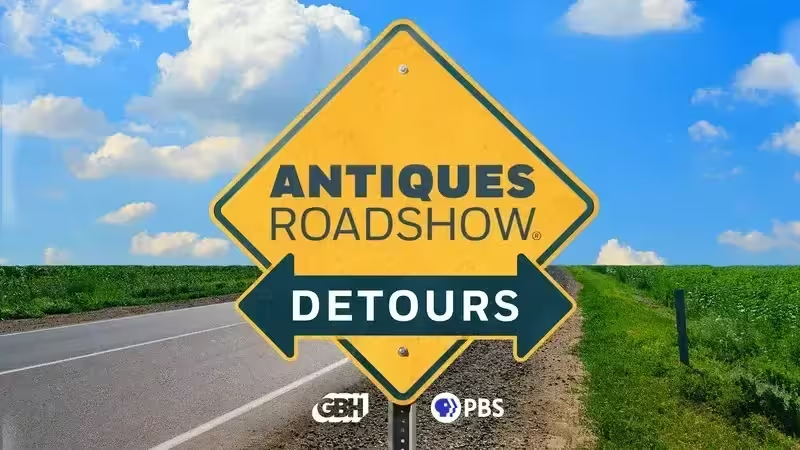
ANTIQUES ROADSHOW DETOURS
Ever wondered what happens to the treasures featured on America’s beloved ANTIQUES ROADSHOW after the cameras leave town? Host Adam Monahan tracks down the juicy afterlives of your favorite finds from PBS’s hit series.Providing Support for PBS.org
Learn Moreabout PBS online sponsorshipMore from This Collection
Check out all of our Junk in the Trunk specials!
Video has Closed Captions
Catch a trunkful of never-before-seen treasures from ROADSHOW's season 27 tour. (52m 26s)
Video has Closed Captions
Discover all new appraisals from ROADSHOW’s Season 26 tour, like a find of up to $75,000! (52m 27s)
Video has Closed Captions
Discover never-before-seen surprises from our Season 24 tour. One is worth up to $100K! (52m 45s)
Video has Closed Captions
Discover never-before-seen appraisals from all Season 23 cities, like a $40K-$60K find! (52m 29s)
Video has Closed Captions
ROADSHOW’s bigger-than-ever 2014 season includes a second hour of junk! (53m 10s)
Video has Closed Captions
Discover more previously unseen appraisals from our eight-city tour. (53m 10s)
Providing Support for PBS.org
Learn Moreabout PBS online sponsorship♪ ♪ CORAL PEÑA: We've saved some of the best appraisals of the 2023 "Roadshow" tour for last.
GUEST: My godfather gave it to me as a gift, 'cause, to be honest, I am the favorite.
(chuckles) You are kidding!
PEÑA: It's "Antiques Roadshow: Junk in the Trunk."
♪ ♪ PEÑA: The Rural Life Museum at Louisiana State University was the first stop on our season 28 tour.
They're just like little finger puppets.
Right, little finger...
So you would just put them in here and... Have a good time.
...have a party: "Hello!
Hello!"
PEÑA: And even though not all the news was good news... APPRAISER: When I look at this under a magnifying glass, it's composed of hundreds of little photographic pixels.
It is a reproduction of a painting.
PEÑA: ...everyone was happy to be sharing their treasures.
Beautiful day in Baton Rouge.
GUEST: We went to a country auction less than a year ago, and this is the only thing I was waiting for for the whole auction, and it was, like, the end of the day.
There was me and this one lady that was bidding on it, and I kept bidding, and she bid, and she finally gave up, and it was, like, $40.
My husband's looking at me, like, "You paid $40 for that?"
(both chuckle) This was made in Venice, and it was designed by a young architect named Alessandro Pianon, and it was made by a company called Vistosi.
Pianon designed this in 1963.
And there were whole series-- he had a family in different colors and shapes.
Oh, my goodness.
They're not signed-- my experience is that they're not usually signed, so there, but there was a, there is a possibility, at one point, it had a paper label on it.
Okay.
And so a lot of those paper labels disappear.
You have this beautiful blown glass and these copper legs and these wonderful eyes, those little n, murrine eyes, where you see the different colors in them.
Yeah, I liked that when I saw it-- that's one thing that attracted me to it.
It's a very sought-after piece.
People love this.
Really?
Because there's such a strong interest in mid-century design.
This piece, in a retail venue today, would sell for between $7,000 and $9,000.
(laughs) You are kidding!
I'm not.
(both laughing) Oh, my-- oh, my goodness.
I'm stunned, I am... Um... And here I am just swinging it around here when I got here today!
I was, like, holdin' it by the feet.
(both laugh) Oh, my gosh, that's, oh, wow.
I had no idea-- that's fantastic.
My grandmother was a weaver for the Dorothy Liebes studios.
Besides doing that as her day job, she learned how to do tapestry weaving.
This is one of the earlier ones she did.
We call it "George and the Dragon," probably late 1940s, early, early 1950s.
And then, as she became older, she was doing things that reminded her of home.
She's Danish, and this one here is of Denmark, with the runestones and the heather.
It is fantastic that you brought these two pieces in, tapestries woven by your grandmother, Kamma Zethraus, who was the star weaver in the studio of Dorothy Liebes.
Dorothy Liebes basically is the godmother of weaving in this country in 20th-century America.
So to see these is great-- they are fiber art.
It's textile art.
It's very different from what Kamma would have been doing in the workshop with Dorothy.
The nine-to-five weaving was a commercial weaving.
You had said this one you thought was late 1940s, early 1950s, and I, I would have probably guessed the same.
And my reason for thinking about circa 1950 is because of this use of Lurex, which, Lurex was only invented in 1946.
It is a metallic substance that is then sandwiched in plastic, effectively.
Ah.
It doesn't tarnish, and today, 70 years later, it still looks like silver.
As modern as this fabric is, the scene is picking up on a totally different tradition.
What we see here is St. George and the dragon in a very modern and very different context.
So this piece closest to you, when do you think your grandmother wove it?
So I think it was in the 1970s.
It was more marketable, in a way, this Modernist, abstracted style.
The different textures, the longer cut yarn versus the flat weave at the top, it's really something that is happening in the late '60s and then into the '70s.
In terms of value, I would put these conservatively at auction in the range of about $1,000 to $1,500 each.
Okay.
I bought a teacup and saucer that I got at a thrift store near our home.
My mom bought it for me for $20.
It was given to me by a past president of the AQHA, Mr. David M. Perkins.
It is the icon-- it's not a specific horse.
It's what a quarter horse should look like.
It was in his barn, and I said, "Mr. Dave, what you gonna do with that portrait?"
He said, "I'm gonna give it to you."
APPRAISER: So, I'm researching this painting.
The story, uh, that this was, you know, previously through David Perkins, is quite compelling.
So I'm, I'm still kind of researching some potential attributions.
INTERVIEWER: Is this the largest horse painting you've ever had to do research on?
APPRAISER: It, it definitely is.
(man laughs) We were going through my dad's comic books, and we found the Michael Jordan rookie card.
His mom bought them for him when he was around my age.
He found them at a swap meet.
He said that she wouldn't have paid, like, more than $50 for all of them.
(chuckles) The card closest to me, this is the famous Michael Jordan rookie card, 1986-87 Fleer card.
Jordan's rookie year was the year prior.
Uh, because of licensing issues, Fleer came out with the card a year later.
You could buy a pack for 30 cents.
Yeah.
Now, if the card was in there, wonderful, right?
Yeah.
Hit or miss.
You got lucky if you had the sticker in there with it, right?
Yeah.
And that's, that's what the card closest to you is.
Yes.
Really, truly, this is among the best cards in, in sports.
Yeah.
Certainly in basketball.
Value is a finicky thing with cards because of condition.
We think it's probably closer to, on a one-to-ten scale, a two or three grade, maybe closer to a two.
There are some issues with the corners, but at auction, the rookie card, closest to me, would sell for $2,000 to $2,500, okay?
The sticker, again, some issues with condition.
That probably sells for $400 to $500 at auction.
So you have an idea now of where you, where you sit, and... Yeah.
What to look for.
Yeah.
Convince your dad to go buy some more.
(chuckles) (chuckles) My father purchased it, and before he passed away, he handed it to me.
He purchased it in Athens, Greece, in 1978.
He paid $1,170, I think.
He was in the military?
Yeah.
It's a French sculpture of Joan of Arc.
She was the Maid of Orléans, or Orleans.
Mm-hmm.
Of course, New Orleans is named after the Duke of Orléans.
She started seeing visions when she was 13 years old, and these visions told her that she should lead the French army against the English.
And she was extraordinarily successful doing that.
She led the French to victory in, in 1429.
At this time, she was 17 years old.
She received sainthood.
Mm-hmm.
Not until the 20th century.
But she is the patron saint of, uh, military people and soldiers.
This piece was originally conceived around 1890.
It is a monument in Normandy to soldiers.
And there's a version of this.
It's inscribed, her words: "You can chain me, but you cannot chain the destiny of France."
She was burned at the stake in 1431, at the age of 19 years old.
She was tried and convicted of heresy.
She was also convicted of blasphemy because she wore men's clothing.
It's signed E. Barrias-- his name was Louis-Ernest Barrias.
He was a very, very prominent sculptor in, in the 19th century.
Unfortunately, today, nobody knows who he is.
His most famous work is on the façade of the Paris Opera.
The monument was around 1890, so this piece was probably in the 1890s, beautifully cast.
This is sort of the high point of French bronze work.
In terms of value, French 19th-century sculpture is not particularly popular these days.
Nonetheless, it would have an auction value in the, uh, $6,000 to $8,000 range.
Oh, that's nice.
It could be insured for $10,000, $12,000.
PEÑA: "Roadshow" was ready for the terrific turnout at the North Carolina Museum of Art in Raleigh, with nearly 3,500 attending.
There were lots of smiles and surprises.
MAN: Hello!
Oh!
(all laughing) (laughing): Oh, you scared me!
PEÑA: And everyone got a free appraisal.
But fewer than 150 guests were lucky enough to be chosen to be in front of our cameras.
Did their luck pay off?
GUEST: I brought a silver tray that my husband and I bought on our honeymoon in 1957.
I will admit, though, that we needed an air conditioner awfully bad.
And to use the wedding check that we'd been given for a silver tray was against my better judgment.
(chuckles) What do you know about the family whose crest is represented?
Well, we've learned the Williams family lived in Cornwall beginning in the late 1700s, and they owned copper and tin mines.
Tell me what you know about the inscription on the back of the tray here.
The inscription is a gift from a man named Charles Williams to his aunt and uncle Caroline and William Williams at their home, Tregullow.
This is in Cornwall.
We recently found out more about this.
The Williams are still in the house.
They have gardens open to the public.
We emailed, and told them we had the tray from their forebears, and asked them if they were interested, and they emailed back, sort of a polite reply, not really interested.
There are hallmarks-- in this case, five different marks, one of which is a sterling mark, one is a London mark, another is a date mark.
And then there's a fainter mark that says "JC."
JC within an octagonal cartouche and an N date mark will indicate that John Crouch II made this tray... Mm.
...in 1808.
1808.
He was a second-generation silversmith.
Uh, his father was a silversmith, as well, and he did incredible work during George III's reign.
Characteristic of a George III tray is a gadrooned border, interrupted by shells, which are further chased to enhance their appearance, the figural lion's mask handles, which are really nicely cast and well-drawn, well-decorated, and, of course, engraving throughout, centering the crest of the Williams family.
What did you pay for it at the time?
$500.
Mm-hmm.
The appropriate auction estimate, in my opinion, would be $8,000 to $12,000.
Seems like a pretty good return on investment to me.
It does-- I'm, I'm...
It's wonderful, thank you.
If you were to insure it, we'd suggest an insurance estimate somewhere closer to $20,000.
Okay.
GUEST: I went to the World Science Fiction Convention called MidAmeriCon, and that was in '76, Labor Day, in Kansas City.
And they had a "Star Wars" room there.
And they had the Darth Vader costume on a mannequin.
Wow.
And I went right up to it and, like, "Ah, evil!"
(chuckles) And I came back the next day, and there's a bunch of people in there, and there's this blonde kid.
And one of the people come up and say to me, "Do you want to buy a poster?"
Mm-hmm.
And I said, "Sure, yeah."
I'm, I'm easy, you know?
And, "How much?
", and he said, "$1.75."
Said, "Can't beat that," so I bought the poster, and then he said, "Do you want him to sign it?"
I was thinking him, the comic book artist that did, that did the poster.
You know, he was famous, you know, Howard Chaykin.
So I said, "Okay, yeah, I'm cool."
And I took it over to the blonde kid, and he wrote, "To Judith, love and best wishes, Mark Hamill."
Mark who?
(laughs) And I thought, "Oh, well, he must have something to do with the movie."
Duh, yeah!
(laughs) (laughs) So that's how I got it-- I know it's worth something.
So I kept it, tried to keep it in good shape.
What an amazing story-- that's, that's incredible.
(laughs) Although not really, not that surprising.... Yeah.
...the fact that you didn't actually know at the time who Mark Hamill was.
No, nobody knew.
(laughs) Nobody knew, yeah, yeah.
Yeah.
If it had been, maybe, Harrison Ford, you might have heard... Well, if it had been Harrison Ford, I would have paid attention.
(both laugh) This poster from 1976... Mm-hmm, mm-hmm.
...is, is pretty cool, because it's actually the very first "Star Wars" poster, it's the advance poster, which came out before the movie came out...
Right.
...which came out the following year, in 1977.
Yes.
It's a very unusual poster in its own right.
What makes it incredibly rare is the fact that you've got Mark Hamill's signature... Hamill.
...just here.
Right there.
Now, he's very difficult to get to sign these days.
He's not someone that readily gives out his signature.
Right.
Which really elevates this piece in terms of value.
Okay.
So there's a couple of things here with the poster that we have to bear in mind.
You probably had it up on the wall, did you, at some point?
Mm-hmm.
Because it's got some pinholes here.
Yeah.
So that does affect the value, because poster collectors want something that's in perfect condition.
Right, that's pristine.
However, I think the signature does make up for that, so...
Okay.
...if this were to appear at auction...
Okay.
...you'd probably be looking at between $3,000 and $5,000.
So about what I figured.
But I think there's every chance that you could realize more than that, because it's such an unusual item.
Right.
There would be very few of these posters that were actually signed by Luke Skywalk...
Right.
Sorry, by Mark Hamill...
Right.
...in 1976.
Right.
From our research, we've determined that this is a railroad track leveler, probably from 1930s, used mainly on curves.
See how it's notched on the end there, so that you can go like this and get your right slope for the tracks.
GUEST: This was a piece at my great-aunt's house.
APPRAISER: It was made by Dominick and Haff, H-A-F-F, and the reason why we know that is because it has this mark here.
Uh-huh.
And they're a very, very big, very well-regarded New York firm.
Do you know what it is?
You would know more than I would, Dad.
Do we know what it is?
Sterling silver, I believe!
(both laughing) That's, that's as much as I know.
Hope so, yeah.
I hope.
(all laughing) It is, it is sterling silver-- it's a bread basket.
You got this nice geometric design on it, wonderful flowers, and it does have-- it's hefty.
I think if this could come up for auction, you'd probably be looking at somewhere between $2,500 and $3,500.
Okay.
But if you were thinking about retail, you'd have to ask something like $7,500 for it.
Okay.
This, I believe, is called a candle table.
It, uh, came from a farm that my grandfather purchased from the Watervliet Shakers.
And this is a deed following through, showing to my grandfather and then to my father.
So what we have here is a wonderful Shaker candlestand made about the m, mid part of the 19th century.
So sort of circa 1850.
The Watervliet community of Shakers, which was a, you know, a, a religiously founded community, was one of the first communities of Shakers to start and come to the United States.
And that's basically outside of Albany, New York.
Right.
And they came as early as about 1775, 1776.
What's really special about this is that you've got this line of descent from the, the farm property through the Shakers to your family.
Mm-hmm.
There are certain Shaker communities that are known for producing Shaker furniture for commerce.
The Watervliet Shakers w, were not known for producing furniture.
And Watervliet-- any idea what their commerce was?
Basically, seed production.
Maybe the first ones to sell packaged seed.
Absolutely.
The first sort of mass-produced seed producers...
Okay.
...that sold it in the little packet envelopes.
It's a wonderful, as you say, cherry wood candlestand.
When I look at this wonderfully turned standard, I mean, l, look at the crazing of the surface.
It's just sort of like an archaeological site that hasn't been touched.
(chuckles): Right.
I mean, it, it's, it's awesome.
Before they put the top on, they put this iron band on, which was a way to hold this together and prevent it from, from breaking apart.
Okay.
Functional, beautiful craftsmanship.
It's just a terrific piece.
If this were to come to auction, I would probably put an estimate of $2,000 to $4,000 on it.
Very good-- sounds great.
My grandfather worked with Theodore Roosevelt's brother-in-law.
Curtis gave the photograph to Theodore Roosevelt, gave it to his brother-in-law, and my grandfather worked in the same office, and Mr. Robinson gave it to my grandfather.
(chuckles): My mom wasn't a fan, and she kept it covered a lot with other pictures, so... Oh.
(chuckling) Oh, okay, okay, got it.
(laughs): What do you know about the figure who's in the image?
I know it's Red Hawk and that he fought against Custer at Little Bighorn, and he also fought with Crazy Horse against the U.S. Army.
This is a very iconic, famous photograph by Edward Curtis.
It was taken in 1905.
The title is "Oasis in the Badlands," and it does depict Red Hawk, an important leader.
Red Hawk was a member of the Oglala Sioux tribe of what's now considered South Dakota.
This image was made in the Badlands.
Curtis was very, and is very famous for photographing Native Americans.
This was his life project.
He won a contest for the prettiest child in America, and the picture was reproduced, which is how he came to the attention of Theodore Roosevelt, who is then president.
He visited Roosevelt, he photographed his children, and then shared his idea for this sort of monumental project documenting Native Americans, not just in the Dakotas, but across the entire United States.
Roosevelt said, "You should talk to J.P. Morgan," who ultimately funded this project.
Curtis's goal, his idea, was to document and preserve, uh, culture that he felt was disappearing.
He's really known for portraits and for evoking this sense of nostalgia, romanticizing his subjects.
This is a singular work.
We don't usually see them this big, in this large-scale format, and that is truly special and unusual.
If this were to come in to auction, I would put an estimate on the photograph at $30,000 to $40,000.
Oh, wow.
Um, for a replacement value, I would suggest a value of $70,000.
That's amazing.
(both laugh) Thank you.
Without that provenance, at auction, I might have said $20,000 to $30,000.
PEÑA: "Roadshow" brought out the treasure hunters in Akron, Ohio, where the Stan Hywet Hall and Gardens was the perfect setting for our event.
Penny saved.
That's the original socket.
Uh-huh.
A lot of times, people change it, but that's correct.
Does anyone want to buy a duck?
It's... Not even one you can cook!
(laughs) Right.
PEÑA: The wide range of art and objects that come into "Roadshow" never fails to fascinate.
He's Gippy, the mannequin baby!
He's from the '40s or the '50s.
He's very precious to our family.
He's been to family weddings, family funerals, and now he's going to go to the "Antiques Roadshow"!
(chuckles) PEÑA: Check out this fascinating find.
The item is actually a lavalier necklace that had belonged to my grandmother.
My grandmother was an Army nurse at Walter Reed Hospital during World War I.
After the war, she was a school nurse that met a local industrialist who owned a company that manufactured hearses and funeral cars.
And they married in 1930.
To be honest, I never saw it until after my mother died, about 25 years ago.
But my grandmother wore it for formal occasions.
It is a stunning Art Deco piece of jewelry.
It is sculptural.
The outline is somewhat of a shield shape.
And in the very center component, you've got square-cut diamonds that are step cuts, and they give the effect of one larger diamond.
You've kind of hit this one out of the park.
Oh, well, thank you-- is, is it platinum?
It is platinum-- it is sculpture in miniature.
It really truly showcases Art Deco craftsmanship.
I did thoroughly examine the piece, but I didn't see any particular maker's mark, and that's not unusual.
An auction estimate would be $3,000 to $4,000.
Okay.
If you were looking to insure it, I think you would be looking at $6,000 or $7,000.
Wow-- wow, that's lovely.
Yeah.
This is a Strand sled.
Strand Ski Company.
We were cleaning out my cousin's estate, and we found this in his garage, and it had about three inches of dust on it, cleaned it up, and then we realized the logo was on there, and it was, like, "Whoa, how cool!"
INTERVIEWER: Do you ever try it out?
No-- no.
GUEST: It's from my grandparents, I don't...
I have no idea where they got it.
Probably, uh, late 1800s on these.
Early 1900s.
A lot of these had a butterfly at that time period.
I guess the butterfly was pretty popular.
Uh-huh.
They weren't easy to make-- you see all these ribs?
That's all individual pieces of wood.
Okay.
These are some of the most undervalued instruments.
It's amazing how much craftsmanship goes into 'em.
GUEST: According to my grandmother, who wrote a little note about it, it is a prototype invention-- the first paper copier ever made.
Okay.
According to her note, it was done by Thomas Edison.
My grandfather didn't get it to work at one time.
It is in fact an Edison-invented item.
It's not a prototype, it's, it's... Mm-hmm.
It's actually a production piece.
It would have been made along with many others of its type, and it was originally marketed as the autographic press.
It's called an electric pen.
Ah.
But it technically isn't a pen in that, in that it writes with ink.
It is a device which makes micro perforations in paper, and you would hold it like a pen.
So let's say you wrote a letter in pen, right?
You would take this device and write over it again.
And as you wrote over it, following the lines of the writing, it would make little micro perfs into the paper, okay?
Uh-huh.
Once you finished that, you would take that piece of paper and you would take it to a special press where you would ink it, and it, it would, like a silk screen, it would press the ink through, and voilà, you would have a copy of that letter.
A copy!
So it sounds crazy-complicated, right?
And it kind of was.
(chuckling) In its day, Edison claimed you could make up to 5,000 copies from one microperfed letter.
A lot of them were sold, and the patent date was 1876.
They were sold to about 1880.
Mm-hmm.
And then what started happening was, a lot of other inventions came along where, "Hey, we can do it this way, we can do it that way."
And then there's this thing called the typewriter, which also kind of really blockbusted the market... Yeah.
...and made this rather obsolete.
The simple function of it is that there's an, you have an electric motor here.
Ah, uh-huh.
That, when powered by a wet cell battery, would rotate that wheel, which would drive a little, uh, cam that would push a needle in and out at a very rapid pace.
Uh-huh.
Have you ever had a tattoo?
Do you have a ta, any tattoos or any... (chuckles): No, I don't.
Okay, so it's kind of like a tattoo needle.
In 1891, an, an entrepreneurial New York tattoo artist looked at this design and said, I can adapt that for tattooing.
Tattooing!
At auction, one like this, without all the other gizmos that I mentioned, would easily sell in the $10,000 to $15,000 range.
Oh, my!
(gasps) (laughing): I can't, I can't believe-- my sisters and I recovered it from a ba, from my dad's basement!
To me, it's beautiful, and it's just a, a, an amazing little object.
And I love it-- it's a jewel.
It was my grandparents' painting.
My grandfather bought a house in Shaker Heights, on South Park.
It was a pretty big house.
He got it on a foreclosure.
My grandmother needed to put a lot of paintings on the walls, 'cause it was a big house.
So I think in the late '40s, she went-- early '50s-- she went shopping and bought a whole bunch of different paintings.
Mm-hmm.
A lot of 'em very nice.
Mm-hmm.
This is one of 'em.
Any idea what she paid for it?
No, no idea.
After they passed away, my one aunt came to own this painting.
And then, uh, when she sold her house, uh, she gave it to me.
When did it come to you?
Uh, just this year.
So the work is by Edward Dufner.
Dufner was born in 1872, and had a long and prolific life, and died in 1957.
And Dufner grew up in and around Buffalo, New York.
At the age of 15, he studied at the Buffalo Fine Arts Academy.
So he was very precocious in his youth, and did so well there that he actually earned an Albright scholarship.
And that scholarship allowed him to travel to New York City in 1893.
There, he studied at the Art Students League, which is one of the prominent places for American artists to study at the end of the 19th century.
After that, he went to the other important place to study, which is Paris.
Every American artist from the late 19th century, or virtually every, ends up going to Paris to study.
It's to sort of get your street creds.
Everybody thinks much more of you, and you can charge more for your paintings.
He went to the Académie Julian, and was actually overseas for about five years.
And at that time, he also studied with Whistler.
When he came back, he went first to Buffalo, and his style was fairly Tonalist.
And by about 1907, he was in New Jersey, and his paintings started to change.
He purportedly saw an exhibition of Willard Metcalf paintings, who painted bright, light, American Impressionist pictures.
And that's when his style changed to this.
Today, when we think of Dufner, this is the sort of style we think of.
We think of light-filled and bright.
He became known as the painter of sunshine.
And this is the iconic subject matter.
What people want are the images of young girls, maybe with a mother, sitting in dappled sunlight by the edge of a lake, maybe with swans or ducks swimming in the distance.
And, I mean, you have every single possible element.
He creates these beautiful oil paintings on canvas, as you're seeing here.
Uh, and this is a fairly large example.
Also going for it-- this is probably the original frame.
Probably this and the painting are from the early 1920s.
He really painted like this throughout the rest of his life.
And this is just what you look for when you, when you look for a Dufner.
If I were to put this through at auction, I would estimate it at $15,000 to $25,000.
Okay, not bad.
He did these quite a bit.
They're eye candy, they're beautiful.
Yeah.
So they were tremendously popular.
♪ ♪ PEÑA: Old Sturbridge Village became a town full of antiques and art collectors when "Roadshow" arrived.
One question on everyone's mind, as treasures from all over the world come through the lines: "How did you get it?"
GUEST: I bought it from a, a fellow mason who was also an antique dealer.
GUEST: My grandparents had it ever since I was little; I'm 68.
I have a feeling it's appreciably older than that.
PEÑA: Another crucial question for our guests: what's it worth?
Our experts have the answers.
I bought them to honor my mother.
She had a big collection of art, various kind of arts.
And one thing that she collected were jewels.
These are, uh, jewels that she, uh, gave to me on various occasions in my life.
Around Christmas time, she would actually give each woman in the family a gift.
And an example of that is the little flower Mm-hmm.
that came with various stones.
So each woman got a different stone.
(chuckling): I got the diamond, and I think that it may be from Van Cleef and Arpels.
And indeed it is Van Cleef and Arpels.
It is stamped "VCA" in the back with a stock number on it.
They were scatter pins, and they would be set with diamond, emerald, sapphire and ruby.
It's approaching between a carat and a carat and a half.
Always very good color and clarity With Van Cleef and Arpels jewelry.
These sweet little demure Van Cleef and Arpels flower brooches are just highly desirable.
You're looking at anywhere at auction between $2,500 and $3,500.
Oui.
The little kitty has a black onyx belly and a cabochon emerald eye that's stamped "VCA" on the back of its ear.
Whimsical animals, and specifically cats, do great on auction.
People are very passionate about cats.
This one is going to be around circa 1950.
At auction, $2,000 to $3,000.
And then we have these great Bombay turquoise and diamond earrings.
Beautifully done, very wearable.
And they are clip-ons, which would be apropos for the 1950s as well.
Made in France.
A conservative estimate would be between $6,000 and $8,000.
Oh.
Conservative, And that's auction.
Okay.
And then we have your little turquoise and diamond in 18-karat yellow gold strawberry.
The total carat weight is going to be approximately five carats on the top here.
That does have signature on it.
It's made in France.
We would have to do a little bit more research on it to find out who the maker was.
Okay.
But it is the same quality as the others.
The strawberry is going to be anywhere between $7,000 and $9,000.
Oh, my goodness.
Yeah.
So unexpected, yes.
And it's a beautiful turquoise circa 1950s jewelry collection.
Yeah.
I told you, my mom had great taste.
(laughs) GUEST: I have a Civil War presentation sword I acquired in about 2010 from my grandmother.
Gustavus Stanley was an officer, fought in three different regiments, but the last one was the 2nd Cavalry, Maine.
After his death, the sword and a lot of the documents from the company were sent back home to my family in Maine, where it's been for years.
So you brought us a Civil War presentation cavalry officer saber.
And it's a presentation to him by the, the men of Company F, 2nd Maine Cavalry.
Yeah.
He's in Illinois.
He joins the 8th Illinois Cavalry.
He got scooped up by Lee's men May 5, 1862.
So you'd think he'd go to a prison camp, right?
Right.
They didn't really have a good method of dealing with prisoners at the beginning of the Civil War.
There was a system of parole, where essentially Yeah.
you would swear to go home, behave yourself, don't take part in military activities, which made it a lot easier on both sides taking prisoners, because they didn't have to feed them and clothe them.
So he goes home.
Home is in Maine.
So when he's called back to service, he ends up a captain in Company B, 28th Maine Infantry, they go down to the Gulf.
He's captured again.
(chuckles) So, he's in trouble again.
He gets paroled, goes home, and comes back with 2nd Maine Cavalry in 1863.
Now, the sword itself.
It's beautiful.
It's in good condition.
What we see here is a nice acid etch engraving on the blade.
You have a federal eagle on the reverse side.
And we know that it is a German-made sword because the maker's mark on the ricasso is by the firm of Clauberg, out of Solingen, Germany.
A retail price for this sword would be between $8,000 and $10,000.
Oh, wow.
Wow, that's great.
This gentleman saw a lot of, a lot of Civil War service, but he couldn't quite seem to stay out of trouble.
(chuckling): No, he could not.
This is a family heirloom from the 1800s.
It's a Armenian walking suit, um, laced with natural saltwater pearls.
And you told me there were how many pearls on there?
About 50,000.
You couldn't remake this piece, because you're not going to be able to find somebody who would sit down and, and do this work.
Sure.
I mean, you couldn't pay them enough to do it.
With regards to the value of the pearls and the jacket, I'd say there are at least $20,000 worth of pearls.
It's a wonderful thing, and thank you very much for bringing it.
Oh, thank you.
That's awesome.
This is a Red Sox baseball bat from 1951.
I got it as a gift from my godfather, who's Richard Donovan, and he was the bat boy.
I got Ted Williams on there, and Johnny Pesky.
This bat had been in the coat closet at my aunt and uncle's house since we were kids.
And when we'd go over, we would just, like, we'd play with it.
My godfather just, he gave it to me as a gift.
Yeah.
'Cause, to be honest, I am the favorite.
(laughs) Just, just saying.
1951, the Red Sox came in third in the American League.
But they had some great players.
Namely this gentleman right here.
Yeah.
that's Ted Williams, of course.
Yeah.
And Joe DiMaggio's brother, Dom, right here.
Johnny Pesky, all-time great.
Bobby Doerr, Hall of Famer.
This is called a half bat.
We're missing the end here, but that's probably because you guys were playing with it.
Yeah, yeah.
And what baseball players would do is, traditional, they would cut the bat in half Okay.
and then each one of them would autograph it, including Johnny Pesky, Ted Williams, Bobby Doerr, Don DiMaggio.
Mm.
And generally, when they were given out, they were given out to teammates or, or friends of the family, if you will.
Sure.
Which makes sense why your godfather would have it.
Very, very rare to find a half bat.
It's in decent shape, other than the broken handle.
The signatures are bold.
If I were going to put an auction estimate, I'd put it at $2,000 to $3,000.
Great.
This photograph is interesting, too.
This was only given to people who were closely associated with the team.
It's got condition issues.
Right.
Even just like this, it's probably worth about $200 to $300.
Excellent.
Yeah.
Nice.
Yeah.
Go Sox.
(both laugh) My grandfather was a colonel in the U.S. Army.
And during the Bolshevik Revolution in Russia, he was given an assignment to go to Stockholm... Mm-hmm.
where he was going to be military attaché.
When they got to St. Petersburg, the bullets were flying.
But he grabbed the family, put my mother on his shoulders, and they ran, and they got to Stockholm eventually.
Mm-hmm.
Once he got there, he learned that there were members of the Russian court that were trying to escape because the monarchy was being killed.
Mm-hmm.
So he said, "I can help them."
So he got in touch with the ladies in waiting, and he did help them, but they took their hymns and ripped the hymns up and produced some jewels.
And they said to him, "We would like to give them to you."
And he said, "No, you're not going to give them to me.
"I will pay you for them, and I will pay you better than they're worth."
And that's exactly what he did.
And so we now have those jewels in our family.
We have the receipt from the baroness who met with him.
And the letter says that the baroness has received 3,700 kroner from my grandfather.
And the date is October 8, 1920.
The ladies in waiting at the court, at the Imperial Court of Russia, are not servants.
They're confidants and secretaries, and, um... basically friends of the empress.
Exactly.
So she might have been a baroness and a confidant to the empress... Mm-hmm.
and maybe they were gifted Mm-hmm.
by the empress to her.
Mm-hmm.
In terms of their date, Okay.
they're between probably 1860 and 1880, give or take.
We've got two fitted boxes from some retailer in Moscow.
There are no marks on any of these pieces, But they're, however, um, indications that it was of the sort of jewelry, clearly, th-that was worn in court settings because it's very fancy, very big and impressive.
These pieces are silver-topped, set with mine-cut and cushion-cut diamonds and carbuncle garnets.
The garnets are large and very dark.
They're hollowed out from behind, and then they're backed onto polished yellow gold, so that you get a light, almost ruby-like color.
I see between 12 and 14 carats of old diamonds.
And the garnets, of course, enhance it for color and, and light.
But, most importantly, it's pre-revolutionary Russian court jewelry.
Mm.
And in a retail setting, I would see a price of $12,000 to $15,000...
Okay.
...on this collection.
Nice, very nice.
I would give it an insurance value of $18,000 to $24,000.
Okay.
It's terrific to see here.
Oh, thank you.
It's absolutely terrific to see here.
Thank you so much.
♪ ♪ PEÑA: At the Alaska Native Heritage Center in Anchorage, "Antiques Roadshow" continued to do what we do best.
This would have been made at the peak of the whaling craze.
PEÑA: Discover hidden treasures, which included a bunch of works by public television's favorite art teacher, Bob Ross.
One Bob Ross painting that stood out: a beautiful Alaskan scene of the northern lights.
GUEST: This painting was hanging in my parents' home, and we gained it at home in 2012 and stuck it in the closet for four years.
(chuckles) The Kenai Peninsula had a 7.1. earthquake.
Wow.
And we had a set of moose horns hanging above our bed.
(laughs) And after the earthquake, we decided that... we're taking that down.
The painting came out of the closet, and we hung it up.
So, did you know it was a Bob Ross painting when you put it into the closet?
No, we did not.
Mm-hmm.
It was sometime after that, we see the signature, and we're like, "Wow, we got something here."
Mm-hmm.
Bob Ross is a public television legend.
He taught so many people to not only to paint, but to enjoy painting.
He made it safe to make mistakes.
He was telling you, "Just, you know, do whatever you want."
Mm.
Paint a little happy tree or a little, you know, happy cloud.
(chuckles) And it was so refreshing, because the other painting teachers were trying to teach you formal painting.
This is an oil on canvas, and it's signed in the lower lefthand corner.
It says "Ross 79."
And it's painted with a technique we called wet on wet, and just add on layer on layer without letting it dry.
It allows you to make a painting really quickly, and as Bob Ross did on his show, under half an hour, he could have an, an complete painting.
It's been reported that Bob Ross painted over 30,000 paintings during his lifetime, which is a crazy number of paintings.
In 1983, he started doing his "Joy of Painting" TV show.
From that time forward, all the paintings he did were owned by the Bob Ross company.
All of his previous paintings are on... kind of on the open market.
We don't see them that often in the lower 48 states.
Mm, okay.
I would give an auction estimate for this painting of $15,000 to $20,000.
Wow.
That is amazing.
That's incredible.
$15,000 to $20,000 is a conservative estimate.
For particularly good ones-- which this is-- I could easily see it hitting $25,000, maybe even $30,000.
(softly): Wow.
Yeah.
That is... unbelievable.
Isn't it crazy?
That is crazy.
GUEST: We were just going for a walk up our street, and a few houses down, there was some items on the curb, and my husband said, "We'll get it on the way back," And I said, "No, no!
These plates are too nice."
"Well, let's take them now."
His name is Robert Mayokok.
He is Alaskan Native.
He pursued the traditional ways.
And so all of these activities, he understood, he had participated in them.
These are hand-painted.
He was a fairly prolific artist.
If they showed up in an antique shop, I think we could say a price on them of at least $50 or $60 each.
Oh, wow.
Awesome.
Thank you.
GUEST: There was an auction for youth hockey in 1990s.
I bought it for $100.
He signed it, which I was told he rarely signs anything.
And you're a hockey mom?
Yes.
And we have Snoopy here with a hockey stick.
This is a really nice, big, bold signature.
He did occasionally take these prints and sign them for charities, but not that frequently.
And the most important distinction here is that this is a print.
It's from a 1982 strip.
If this were original, it would be worth quite a bit more.
It's still probably an $800 to $1,200 piece.
Oh, okay, great.
You struck gold in Alaska here.
Yeah.
Great.
♪ ♪ GUEST: We have 17 Sheldon Jackson reindeer reports from 1893 to 1906.
So this is just part of our collection.
And because my grandfather was a reindeer herder and his name is in some of these books, that's... that was our interest in them.
I'm learning things in Alaska, never having come to Alaska before, and I'm grateful to be here and to, to learn about the reindeer.
I did not know that they were not indigenous to Alaska, they were introduced.
The reindeer's cousin, the caribou, is indigenous to Alaska.
My ancestors, their main source of food, if you're on the coast, were sea mammals-- so whales, walrus, and seals.
And now back in the 1800s, so many of them were taken by-- in the whaling ships... Yeah.
...around the world, and so, that left very little food for my ancestors.
And Sheldon Jackson, the education agent, saw that.
He had heard that other countries were raising reindeer for food, and so he thought it would be good to try that in Alaska.
Yeah, and it was something that indigenous people in, in other parts of Siberia and other parts of Scandinavia did as well.
Right.
The books are so interesting, because they are, as they say on the title, reports of this program.
So, in addition to your grandfather's name, they have the names of all of the people that were involved in the program, and, of course, the numbers of animals and then how the program was doing, which is, which is fascinating.
Because they are reports for an ongoing government program, the only way you can really get them is in the original editions as they're coming out each year from the government printing office.
There's photos in there, there are maps.
We can look at a photo.
It does show milking reindeer.
The female reindeer were only meant to be given to people in the community only.
They wanted to keep the new tradition of herding among indigenous Alaskans.
These books are important to you personally, and it's also such an i... an interesting moment in the history of this very diverse place of Alaska.
A lot of these, we bought 40 years ago...
Right.
And we have no idea what they're worth now.
Yeah.
The price range varied; the average was about $50.
What I see right now on the retail market is individual volumes selling for about, more like $100 to $200.
Mm-hmm.
I brought an antique presentation cane that was presented by my great-great-grandfather to his son in 1855 in Philadelphia.
It has a sterling silver cap where the presentation engraving has been placed, and then this beautiful wood that is from the timbers of Independence Hall.
I think a conservative auction estimate would be $1,500 to $2,500.
Mm-hmm.
And I would insure it for $10,000.
Oh, really?
Mm-hmm.
And that's based on the fact that a similar cane, estimated at $1,000 to $2,000, sold for $11,000 in 2020.
(laughs) Okay, great.
Thank you.
It is, I thought, the only sled left from the first Iditarod.
I'm one of only nine still alive from the first race.
I found out later, my friend Dan Seavey has one in the museum in Seward.
When was the first Iditarod race?
It begun in 1973, with the goal of getting the Iditarod Trail commemorated as part of the National Historic Trail system.
I found that the actual original Iditarod Trail was created largely during the gold rush years in the early 1900s?
Yes, it was.
It was Seward to the gold rush town of Iditarod.
There were trails coming in off of the Yukon from Nome and also from Fairbanks to Iditarod that all became part of the Iditarod Trail.
That old trail had not been coursed for over a half century, and it was just... had to be relocated and recreated, and it was one monumental job.
Dog teams existed until, uh, the snowmobile came, and all of a sudden, almost overnight, where there were hundreds of thousands of sled dogs across the north, within about a five-year stretch, there were almost none, and we had to do something to save them.
How did you build this sled?
The stanchions are hockey sticks.
The rest of it's hickory, and it's all steamed and bent.
I designed it, and I got three friends going, and they worked day and day... and night for three days and nights without going to sleep to finish it in time for the race.
It got me a thousand miles.
S... And this was my shelter as well...
This...
I'd jam my snowshoes in the snow... Yeah.
And put a canvas over it, and I'd sleep inside.
No!
Yeah, at 40, 50 below zero.
Wow.
And the dogs survive very well in lower temperatures.
Dogs... Yeah, they're... 30 to 50 degrees...
The dogs are born to it.
They were very well-furred back then, especially.
How'd you know when the dogs are tired?
You just get to know your dogs so well, you know pretty much what they can take.
And I would stop every hour on the hour to check their feet.
And then about every three hours, I'd give them a snack, and, and a good meal at the end of a, of a run.
What was it like when you finished?
I was so high, knowing I was actually going to make Nome.
My glacier goggles are fogging up.
And I thought, "Okay, I'm this close to Nome.
"I'm getting sunburned on my... on the left side of my face, "frostbitten on the right side, and I'm going snow-blind, but I don't care.
I am gonna make Nome."
And I got to Nome, and the whole town would turn out, the fire siren would sound, and the mayor would be there, and it was a hero's welcome to everyone.
The whole north was just ignited.
In the last 50 years, the sleds have gotten much more aerodynamic and not as homemade... (chuckling): No.
much more professionally built, right?
But we have this sled here.
And as far as I know, and you know, there's only one other sled that's extant from, from this race, right?
Yes, yeah.
In the museum.
Yeah.
We look at this as a milestone piece.
It's from the first Iditarod.
There's only one first Iditarod.
Only one first race.
An auction estimate on this would be somewhere in the $20,000 to $30,000 range.
Wow.
That's impressive.
I would insure it for at least $40,000.
Okay.
Okay, that's good information, that's very valuable information to have.
PEÑA: And now it's time for the "Roadshow" Feedback Booth.
We have a Renaissance painting from the 1780s... No.
From the 1880s.
No.
From the 1980s.
Yes.
But it's worth about what we paid for.
I'm a retired kindergarten first grade teacher.
I took this to school every year to share with my students.
And unfortunately, one year, one of my students knocked it off the table, hence the broken piece.
My husband said that was the last time I was taking it to school.
We brought these spears and an axe from the 18th century.
Not worth as much as I had hoped, but we had a great time, and we didn't have to wait in any lines.
Everybody got out of our way, It was fun.
(laughs) This is for all my friends here in northeastern Ohio, I brought the-- that are still waiting for the Browns to go to a Super Bowl.
I brought the 1964 championship game program, which I attended when I was in college in 1964, and also my Otto Graham and Dante Lavelli autographs.
Go Browns.
This was an ancient piece of the pyramids of Egypt, except it's not ancient.
(laughs) And it's not worth anything.
(laughing): And it's not worth anything.
I came with some diamonds from my grandmother, and they were appraised at market value.
But, of course, they are always priceless.
And, of course, everyone knows that diamonds are a girl's best friend.
I brought St. Francis to the antique show.
They think it's a couple hundred years old and worth a couple hundred dollars.
The poor guy, his halo fell off.
It happens to the best of us; mine fell off years ago.
As you can see by my shirt, I brought my entire family to the "Antiques Roadshow."
I had a tremendous time getting my Grandpa Bud's World War II items appraised for up to $500.
PEÑA: Thanks for watching.
See you next time on "Antiques Roadshow."
Appraisal: 1808 George III Sterling Silver Tray
Video has Closed Captions
Clip: S28 Ep25 | 2m 32s | Appraisal: 1808 George III Sterling Silver Tray (2m 32s)
Appraisal: 1905 Edward Curtis ‘An Oasis in the Badlands’ Photo
Video has Closed Captions
Clip: S28 Ep25 | 2m 28s | Appraisal: 1905 Edward Curtis ‘An Oasis in the Badlands’ Photo (2m 28s)
Appraisal: 1951 Red Sox Team-signed Half Bat & Photo
Video has Closed Captions
Clip: S28 Ep25 | 1m 55s | Appraisal: 1951 Red Sox Team-signed Half Bat & Photo (1m 55s)
Appraisal: 1973 Iditarod Race Sled
Video has Closed Captions
Clip: S28 Ep25 | 3m 38s | Appraisal: 1973 Iditarod Race Sled (3m 38s)
Appraisal: 1976 Mark Hamill-signed ‘Star Wars’ Poster
Video has Closed Captions
Clip: S28 Ep25 | 2m 43s | Appraisal: 1976 Mark Hamill-signed ‘Star Wars’ Poster (2m 43s)
Appraisal: 1979 Bob Ross Landscape Oil
Video has Closed Captions
Clip: S28 Ep25 | 2m 21s | Appraisal: 1979 Bob Ross Landscape Oil (2m 21s)
Appraisal: Art Deco Diamond & Platinum Pendant, ca. 1930
Video has Closed Captions
Clip: S28 Ep25 | 1m 28s | Appraisal: Art Deco Diamond & Platinum Pendant, ca. 1930 (1m 28s)
Appraisal: Chinese Hand-embroidered Silk Shawl, ca. 1910
Video has Closed Captions
Clip: S28 Ep25 | 33s | Appraisal: Chinese hand-embroidered Silk Shawl, ca. 1910 (33s)
Appraisal: Civil War Cavalry Officer’s Presentation Sword
Video has Closed Captions
Clip: S28 Ep25 | 2m 14s | Appraisal: Civil War Cavalry Officer’s Presentation Sword (2m 14s)
Appraisal: Diamond & Platinum Eternity Band, ca. 1960
Video has Closed Captions
Clip: S28 Ep25 | 1m 3s | Appraisal: Diamond & Platinum Eternity Band, ca. 1960 (1m 3s)
Appraisal: Edison Electric Pen, ca. 1876
Video has Closed Captions
Clip: S28 Ep25 | 2m 34s | Appraisal: Edison Electric Pen, ca. 1876 (2m 34s)
Appraisal: Edward Dufner ‘Hazy Morning’ Oil, ca. 1920
Video has Closed Captions
Clip: S28 Ep25 | 2m 56s | Appraisal: Edward Dufner ‘Hazy Morning’ Oil, ca. 1920 (2m 56s)
Appraisal: Imperial Russian Court Jewelry, ca. 1870
Video has Closed Captions
Clip: S28 Ep25 | 2m 58s | Appraisal: Imperial Russian Court Jewelry, ca. 1870 (2m 58s)
Appraisal: Jewelry Group, ca. 1950
Video has Closed Captions
Clip: S28 Ep25 | 2m 25s | Appraisal: Jewelry Group, ca. 1950 (2m 25s)
Appraisal: Kamma Zethraus Tapestries, ca. 1960
Video has Closed Captions
Clip: S28 Ep25 | 2m 10s | Appraisal: Kamma Zethraus Tapestries, ca. 1960 (2m 10s)
Appraisal: Louis-Ernest Barrias Joan of Arc Bronze, ca. 1890
Video has Closed Captions
Clip: S28 Ep25 | 2m 1s | Appraisal: Louis-Ernest Barrias Joan of Arc Bronze, ca. 1890 (2m 1s)
Appraisal: Robert Mayokok Plates, ca. 1960
Video has Closed Captions
Clip: S28 Ep25 | 47s | Appraisal: Robert Mayokok Plates, ca. 1960 (47s)
Appraisal: Shaker Cherry Wood Candlestand with Deed, ca. 1850
Video has Closed Captions
Clip: S28 Ep25 | 2m 7s | Appraisal: Shaker Cherry Wood Candlestand with Deed, ca. 1850 (2m 7s)
Appraisal: Vistosi Alessandro Pianon-designed Glass Bird, ca. 1963
Video has Closed Captions
Clip: S28 Ep25 | 1m 48s | Appraisal: Vistosi Alessandro Pianon-designed Glass Bird, ca. 1963 (1m 48s)
Appraisal: 1892-1906 Sheldon Jackson Reindeer Reports
Video has Closed Captions
Clip: S28 Ep25 | 3m 4s | Appraisal: 1892-1906 Sheldon Jackson Reindeer Reports (3m 4s)
Providing Support for PBS.org
Learn Moreabout PBS online sponsorship
- Home and How To

Hit the road in a classic car for a tour through Great Britain with two antiques experts.













Support for PBS provided by:
Funding for ANTIQUES ROADSHOW is provided by Ancestry and American Cruise Lines. Additional funding is provided by public television viewers.


